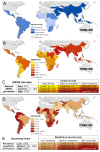G6PD deficiency prevalence and estimates of affected populations in malaria endemic countries: a geostatistical model-based map
- PMID: 23152723
- PMCID: PMC3496665
- DOI: 10.1371/journal.pmed.1001339
G6PD deficiency prevalence and estimates of affected populations in malaria endemic countries: a geostatistical model-based map
Abstract
Background: Primaquine is a key drug for malaria elimination. In addition to being the only drug active against the dormant relapsing forms of Plasmodium vivax, primaquine is the sole effective treatment of infectious P. falciparum gametocytes, and may interrupt transmission and help contain the spread of artemisinin resistance. However, primaquine can trigger haemolysis in patients with a deficiency in glucose-6-phosphate dehydrogenase (G6PDd). Poor information is available about the distribution of individuals at risk of primaquine-induced haemolysis. We present a continuous evidence-based prevalence map of G6PDd and estimates of affected populations, together with a national index of relative haemolytic risk.
Methods and findings: Representative community surveys of phenotypic G6PDd prevalence were identified for 1,734 spatially unique sites. These surveys formed the evidence-base for a Bayesian geostatistical model adapted to the gene's X-linked inheritance, which predicted a G6PDd allele frequency map across malaria endemic countries (MECs) and generated population-weighted estimates of affected populations. Highest median prevalence (peaking at 32.5%) was predicted across sub-Saharan Africa and the Arabian Peninsula. Although G6PDd prevalence was generally lower across central and southeast Asia, rarely exceeding 20%, the majority of G6PDd individuals (67.5% median estimate) were from Asian countries. We estimated a G6PDd allele frequency of 8.0% (interquartile range: 7.4-8.8) across MECs, and 5.3% (4.4-6.7) within malaria-eliminating countries. The reliability of the map is contingent on the underlying data informing the model; population heterogeneity can only be represented by the available surveys, and important weaknesses exist in the map across data-sparse regions. Uncertainty metrics are used to quantify some aspects of these limitations in the map. Finally, we assembled a database of G6PDd variant occurrences to inform a national-level index of relative G6PDd haemolytic risk. Asian countries, where variants were most severe, had the highest relative risks from G6PDd.
Conclusions: G6PDd is widespread and spatially heterogeneous across most MECs where primaquine would be valuable for malaria control and elimination. The maps and population estimates presented here reflect potential risk of primaquine-associated harm. In the absence of non-toxic alternatives to primaquine, these results represent additional evidence to help inform safe use of this valuable, yet dangerous, component of the malaria-elimination toolkit. Please see later in the article for the Editors' Summary.
Conflict of interest statement
The authors have declared that no competing interests exist.
Figures




References
-
- Das P, Horton R (2010) Malaria elimination: worthy, challenging, and just possible. Lancet 376: 1515–1517. - PubMed
-
- The Global Health Group and the Malaria Atlas Project (2011) Atlas of malaria-eliminating countries. San Francisco: The Global Health Group, Global Health Sciences, University of California, San Francisco.
-
- Carlton JM, Sina BJ, Adams JH (2011) Why is Plasmodium vivax a neglected tropical disease? PLoS Negl Trop Dis 5: e1160 doi:10.1371/journal.pntd.0001160 - DOI - PMC - PubMed
Publication types
MeSH terms
Substances
Grants and funding
LinkOut - more resources
Full Text Sources
Medical
Miscellaneous

